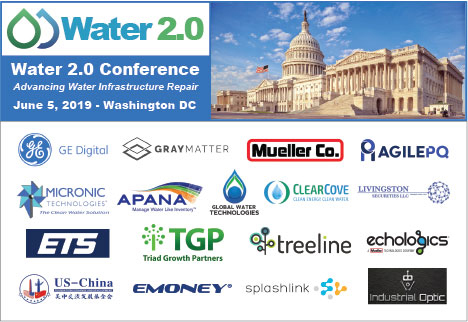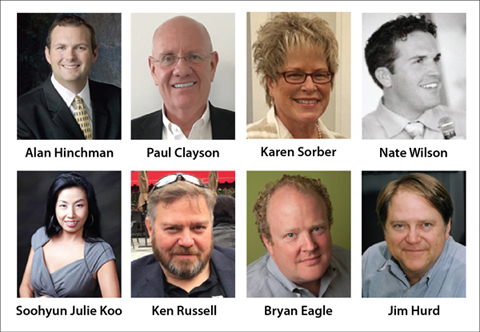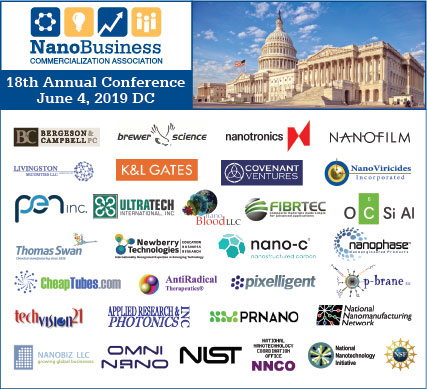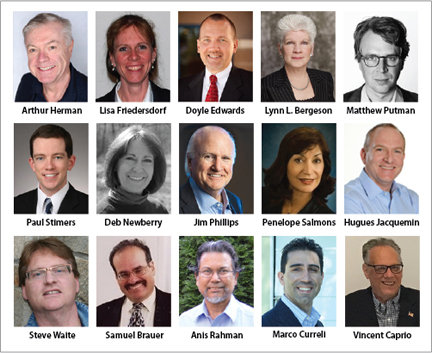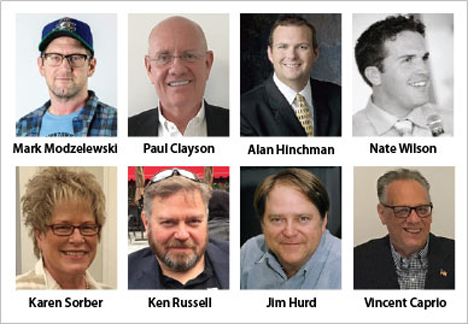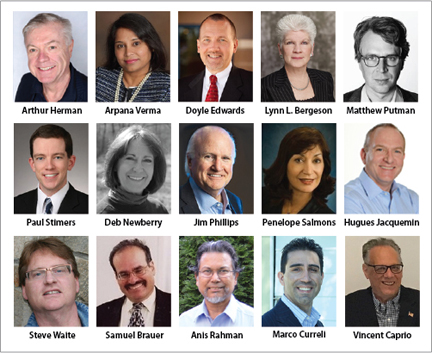NanoBCA Interview: Mihail (Mike) Roco, Senior Advisor for Science & Engineering, NSF
Posted on May 28th, 2019 in Uncategorized | No Comments »
We are excited to share the next interview of our NanoBCA Interview Series. Through this series we offer in-depth interviews with some of the key stakeholders influencing our nanotechnology community today. Many of these dynamic professionals will be participants at our:

18th Annual NanoBusiness Conference
Tuesday, June 4, 2019
CONFERENCE LOCATION

K&L Gates
1601 K Street, NW
Washington, D.C. 20006-1600
Our next interview is with Mihail (Mike) Roco, Senior Advisor for Science & Engineering, National Science Foundation.
Steve Waite: Thanks for taking time to speak with us today, Mike. You have been involved in nanotechnology at a very high level for many years. How did it all begin?
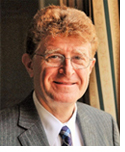
Mike Roco: I started as a faculty of mechanical engineering at the University of Kentucky in 1981 where I became full professor in four years. While at the University of Kentucky, I received two grants through the National Science Foundation (NSF) to explore ultrafine particle dynamics and multiphase systems and several contracts from IBM and other companies to explore small particles in reverse coating and two-phase machineries. In 1986-1987 I was visiting professor at Caltech and Tohoku University. In 1990, I proposed a new research program to the NSF for the U.S. government through the Emerging Technologies competition that encompassed the synthesis of nanoparticles at high rates. That program was relatively small, only $3 million per year over a period of six years.
During this time, I realized that research in this area was a much broader topic that crosses and unifies many scientific fields, with potential to become a general-purpose technology. This realization led to collaboration with experts from diverse fields and the preparation of a report titled “Nanotechnology Research Directions: Vision for the Next Ten Years and Beyond.” It was published in 1999 and was adopted by the National Science and Technology Council, White House, as an official report. This became the foundational document for the National Nanotechnology Initiative (NNI). Later it was adopted in research planning in over 80 countries. It proposed a unified definition of nanotechnology as well as a 10-year outlook for exploration in key R&D sectors and a vision for the next thirty years. This was equivalent to a phase change for the scientific community. Prior to this, only a few people in physics and chemistry were interested. After the unified definition became accepted, other scientists and engineers from many other fields expressed an interest in nanotechnology. The NSF became the playground for the first phase of nanotechnology research. I should note that there was a lot of skepticism in the scientific and industry communities about nanotechnology when we started out (e.g., What is new? When would be the first product?).
SW: There always seems to be a great deal of skepticism when a revolutionary technology is in its infancy.
MR: Yes. In our case, we used the NSF as a playground to ramp up the research in nanotechnology. Over time, the work in nanotechnology blossomed in the U.S. as well as overseas. I am the founding Chair of the Subcommittee on Nanoscale Science and Engineering set up in 2000 at the White House, the interagency organization that steered the NNI. Currently I am Senior Advisor for Science and Engineering at the NSF.
SW: As a key architect of the NNI, what did you see as the need for a National Nanotech Initiative?
MR: To provide some context, at that time the President was looking at creating an R&D program that would have a long-term impact and recognition. A competition was organized by the White House under the auspices of the National Science and Technology Council (NSTC) and Economic Council. In March 1999, I was invited to the White House in the Old Indian Treaty Room to speak about nanotechnology. Then I proposed the NNI on behalf of an interagency group with an annual budget of $500 million dollars in 2001. They gave me ten minutes. Believe it or not, we ended up speaking for over two hours.
SW: Wow! It sounds like you hit the idea out of the park at that meeting.
MR: It was a seminal event for nanotechnology in the U.S. After the event, the White House gave us approval to speak about the potential for a national program. This work became the foundation for the national science, engineering and technology initiative in nanotechnology, which was unveiled by President Clinton at Caltech in early 2000. By 2019, four Presidents (Clinton, Bush, Obama and Trump) have supported the initiative and each highlighted it as a model for S&T national programs. The cumulative investment is about $27 billion since the inception of the NNI including the 2019 budget estimate. After the announcement of the NNI, nanotechnology has become de facto an international science and technology initiative, a competitive domain between U.S., Europe, Asia and Australia. The vision of the NNI has been long term in nature (see: “The Long View of Nanotechnology Development: “The National Nanotechnology Initiative at 10 years”). We saw nanotechnology having an impact on industry and society at large over the course of decades.
To answer your question, the need for the NNI came out of the realization that the control of matter at the nanoscale is important to the entire economy and society. We saw the NNI as fostering the research necessary to control matter at the nanoscale. There was a gap in knowledge between the 1 to 100 nanometer level. People did not have concepts to understand the functioning of matter at this small scale. There was no accepted unifying concept across all the fields. Initially, there was fragmentation. The opportunity we saw with the NNI was associated with the nature of nanotechnology as a general-purpose technology that will have a widespread impact across all sectors of the economy. We saw the NNI as fostering activities that were collegial across scientific fields and across agencies.
We saw nanotechnology evolving through the NNI in three phases. First, one has to develop the basic concepts and components. We envisioned it taking roughly ten years to develop the foundation science and create a library of nanocomponents from most elements of the periodic table. The second phase involved the integration of nanotechnology components in larger structures that are useful nanodevices, biosensors, hierarchical structures of polymers and artificial tissues, to name a few. The third phase, which is expected to be in full effect after 2020, is integration with other systems to be used effectively and economically in almost every product. For all of this to happen, we needed general methods for nanoscale investigation, design, manufacturing, and integration with other emerging fields. By the end of the third decade, the vision is to have methods of design and manufacturing for effective integration of nanotechnology in industry, medicine, space, etc. I think we are on this path.
SW: It certainly seems that way.
MR: Yes. To give an example. As you know, in semiconductors more than 70% are based on nanoscale phenomena and components if we speak about the U.S. based companies. In advanced chemicals, it is more than 40%. About the same for pharmaceuticals. We already see that the penetration of nanotechnology is significant, and yet we are still at an early stage, as the concepts and processes are evolving. Nanotechnology is improving continuously. Once we have the methods of how to design economically at the nanoscale level, penetration will accelerate. We knew when we started that we had to develop this foundational knowledge of how to create larger structures from the nanoscale on up. Where we are now, the critical problem is to be able to create by design and to manufacture larger structures that have multiple functions and can be integrated into larger systems.
Another major challenge today is to integrate nano with bio, information, artificial intelligence, and cognitive science. Other challenges at the present time include the need to do sustainable nanotechnology for global sustainability and to use nano as a condition for modern biology (e.g., gene editing and nanorobotics for surgery). Nano is now an integral part of the revolution in medicine. Within this field, there is a major challenge for nanotechnology to help create brain-to-brain, brain-to-machine, brain-like devices and hardware systems for artificial intelligence. I would also note that a field that started from nanoscale science and engineering is quantum. There is a focus today on quantum communications and quantum computing that stems from the foundational work we have done in nano.
It is important to note that nanotechnology is a foundational field. Since the year 2000, we have seen many spinoff fields. For instance, in 2003 in the Office of Science and Technology Policy (OSTP) we created a quantum science and technology group that was a spin off on the NNI. That was done on a more confidential basis for fifteen years. This year we have a quantum initiative at the national level in the U.S. There are more than twenty fields today that started specifically from the NNI research programs. For example, we started a program in metamaterials in 2004. Within a period of three years, we went from one NSF proposal in this area to hundreds of proposals and thousands of publications.
I would also point out that synthetic biology and plasmonics were enabled as part of the NNI up to 2004 and were subsequently spun off. The Materials Genome Initiative initially started from the nanomaterials-by-design modeling and simulation area of focus within NNI. The basic concepts from the nanophononics area formed a foundation and evolved to be integrated in the 2012 National Photonics Initiative. Other notable fields that were spun out of the NNI research programs and at the confluence with other foundational areas are: nanofluidics, carbon electronics, nanotechnology sustainability, nanostructured wood fibers, DNA nanotechnology, protein nanotechnology, and nanoscale-mesoscale systems.
My point is nano is a foundational field that creates a base and has not only created new knowledge, but new fields of science and new disciplines. There are successive phases of growth to a foundational field such as nanotechnology, as well as many players. There is no ending. There is an evolution that takes place over many decades.
SW: Given what you have learned over the years, what types of things would you have done differently, if any, to make the NNI more effective?
MR: The NNI started out as a science project and blossomed into a unified knowledge base and a community that did not exist before. We also have created a flexible infrastructure for research and production. This would not have happened without the organization that went into the NNI. We can also see that the work associated with NNI has inspired other emerging technologies. When I think about what could have been done differently, we have to recognize that when we began we faced some limitations. One limitation was the ability to engage with industry from the beginning. That said, the NanoBusiness Alliance launched in 2001 at an early stage of the NNI. But there was fragmentation within industry, due to various factors, that limited progress. Nevertheless, industry has adopted nanotechnology, even if it has not been widely advertised over the years. Based on our estimates, nanotechnology today accounts for products that cumulatively represent more than 4% of U.S. GDP, which equates to about three quarters of a trillion dollars.
SW: We vividly recall those trillion-dollar projections for nanotech in the world. Are we there?
MR: Our estimation published in 2001 was that the worldwide revenues from products that have nanotechnology as the key feature for competitiveness would reach one trillion dollars by 2015, of which about one third would be in the U.S. If we use the Lux Research industry surveys, in agreement with other estimations and extrapolations, we reached both of those worldwide and U.S targets in 2013. Now, I would like to add that another limitation was the inability to develop applications quickly caused slower than expected progress in modeling, simulation and design. For example, as we go to larger structures, we cannot use trial and error like we can do with nanoparticles. If you want to build a system, one has to develop better generalized theories that include all of the phenomena and types of interactions. This, in my opinion, is still a place where we can improve. When I look at Environmental, Health and Safety (EHS) I think we have done pretty well overall because we started to focus on this at the beginning. Now the focus is shifting to ELSI (Ethical, Legal and Societal Implications) that have become just as important as EHS because we are moving to larger and more complex systems.
In summary, when I look back certainly some things could be improved. But overall, I think we had a very good macro approach to address the foundational general-purpose technology that is nanotechnology. After 2007, there was a perception that we have the results and now all we need are applications. However, I believe that we must continue to develop the methods for new nanotechnology generations in parallel with translational efforts and applications.
SW: How do you see the NNI evolving in the years ahead?
MR: We have not generalized efficient methods for manufacturing or generalized methods for integration with nanotechnology. In my view, this has to be a focus going forward. We are at the end of the second phase of development I spoke about earlier. The next phase, the third one, will see the development of new architectures for nanotechnology as well as new methods that are generalized and can be applied economically. The moment to capitalize on results we have obtained with the NNI is coming during the next phase, which will take out us to 2030 and beyond. Nanotechnology blossoms into its full potential when you can develop new architectures and integrate it into society economically and efficiently to tackle some of the biggest challenges we see today. We are on the path, but we have a lot more work ahead. I do believe the NNI can continue to play a role in helping to foster the development of nanotechnology in the decade ahead.
SW: You co-authored a book in 2011 titled, “Nanotechnology Research Directions for Societal Needs in 2020: Retrospective and Outlook.” The year 2020 is around the corner. Where are we on your Nanotechnology 2020 roadmap?
MR: That’s a very good question. Almost all the important targets we discussed in the book are on the way. The progress over the past decade has been significant. There is a great deal of work in nanotechnology being done outside of the U.S. There is a realization overseas that now is the time to reap the benefit of nanotechnology, so they are investing more. There is a research challenge as well as a development challenge. I think this has to continue in order to reap the benefits of nanotechnology in the decade ahead. Nanotechnology is an inspirational and enabling field for new science and technology platforms. Key areas of converging technologies integrated from the nanoscale have been benchmarked in more than 30 countries in the report “Convergence of Knowledge, Technology and Society.” Many visionary ideas were initially advanced in the foundational convergence report, “Converging Technologies for Improving Human Performance: Nanotechnology, Biotechnology, Information Technology and Cognitive Sciences,” are on their way of realization.
SW: We have reached the 7-nanometer level in semiconductors. There is a lot of discussion in the semiconductor industry these days about the need for new types of architectures and designs. What role can nanotechnology play in fostering these new architectures and designs?
MR: Nanotechnology offers the opportunity to develop new architectures for computing. We have gone a long way in developing new nanoscale components. Now we have to go to the next phase to create new principles and new architectures at the nanoscale level. Computation in the cell is at the nanoscale level. Computing in the quantum is at the nanoscale level. Computing for photonics and optics is at the nanoscale level. We were discussing quantum when we launched the NNI. A separate spin-off program was created for quantum in 2003. Nanotechnology has the potential to usher in new architectures for semiconductors and for computing such as quantum. The field for these new architectures is completely wide open. In addition, AI offers new ways to design, manufacture and use nanosystems. A key challenge is building the nano-enabled hardware to be suitable and work well with the AI software.
I should add that the NSF currently has a collaboration with the SRC (Semiconductor Research Corporation) and NIST. There are nearly two dozen new ideas of how to progress, even in the nanoelectronics domain. The scientific and engineering challenges we see in semiconductors today are even richer than they were twenty years ago when the NNI was launched. Benchmarking of new computing elements and their assemblies using convergence performance criteria is a promising opportunity of selecting priorities.
SW: How do you see the NSF’s role in nanotechnology evolving in the years ahead?
MR: NSF is addressing all the fields of nanoscale science and engineering. We have about 6,000 active awards focused on upward research going from quantum, to biosensors, to building nanostructures using bio principles from synthetic biology. A portion of these are in so-called core programs where you leave people open to proposing any idea while others are conceptually-driven top-down, so-called big ideas or focused solicitations. In parallel, we have three other activities. One is to create the infrastructure focused on the academic field. The second is education and training. In education we look to various methods, from individualized learning, to virtual reality to using convergence methods. Thirdly, we look to societal implications of the research done and possible applications. The NSF has the most focus on this area. We also look at economic, environmental, health, and ethical issues related to nanotechnology development and the development of other emerging fields in connection with nanotechnology.
I should add that the NSF has a lot of international collaborations. More than 20 percent of the 6,000 awards have formal international collaborations. We train 10,000 students per year, which is a large number. We have about 30 large centers and about 14% of all awards made by the NSF have nanotechnology inside in the last five years. In addition, NSF annually funds about 25 new SBIR/STTR nanotechnology awards, as well an increasing amount for Grant Opportunities for Academic Liaison with Industry (GOALI) for joint academe-industry research awards, I-Corps for innovation training linking completed basic research professionals to entrepreneurs and industry, and INTERN for graduate student internships in industry.
SW: What type advice would you give to a high school student today who is interested in nanotechnology?
MR: Nano is exciting, is futuristic, it applies to all of the material world, and is highly rewarding. For the past several years, NSF has organized a national competition for high school students called Nano Generation. We give prizes to the winners. Next year, this will be merged together with the Museum of Science activities across the U.S. For a high school student, it is essential to follow this line of thought: The specific fields of jobs changes continually. However, if you learn something more foundational, you can cross from one field to another. To have a good salary in the U.S., you need to have a good education. Considering that nanotechnology is a general field that crosses and intersects with many fields, if you learn nanoscale science and engineering well you can find a job in many fields. Secondly, if you have a background in nanotechnology you may have a higher qualification that will put you in a better position to have an interesting and fulfilling job. From a broader intellectual point of view, nanotechnology offers a grand perspective of nature, and how things work around us.
SW: Last question for today, Mike. What type of advice would you give to policymakers today with respect to encouraging the development of nanotechnology in the future?
MR: I do this every day. There are many challenges ahead, increasingly more sophisticated and more impactful. The main technical direction I think now is to construct larger nanostructured systems with more atoms, information and complexity contents that can be integrated economically and to work together with information, quantum, bio and artificial intelligence. Nanotech cannot strive in isolation. Nano is the foundational technology from which other technologies can emerge and evolve. The convergence with other foundational fields such information technology and cognitive science to name a couple, can help foster sustainable economic development.
From my vantage point, nanotech becomes part of the solution in many fields. It is not a solution just for a final product. From the beginning it has to be integrated with other ideas. Those who do nanoscience and engineering are engaged in multidisciplinary science that includes bio, cognitive, information and other fields. In fact, nanotechnology is one of the foundational fields together with digital technology that are general purpose in nature. As a confirmation, nanotechnology is critical to all newly announced WH Industries of the Future (March 2019) to receive priority in funding: Artificial Intelligence, Advanced Manufacturing, Quantum Information Science, and 5G networks. In summary, I see nanotechnology evolving to larger, more sophisticated systems that maintain the nanoscale behavior at the smaller scale while at the same time integrating with other emerging technologies.
SW: Thank you for your time today, Mike. The NanoBCA commends you for all of the great work in nanotechnology you have done over the years. We wish you all the best in the future.

——————————
Steve Waite is the author of several books including Quantum Investing and Venture Investing in Science.
——————————
I hope you enjoyed this month’s interview. Our 18th Annual NanoBusiness Conference offers outstanding opportunities to connect with a diverse nanotechnology-related group of professionals in the heart of Washington DC. We hope you will be able to join us on June 4th!

